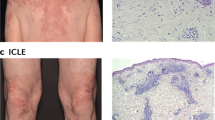Abstract
THE elusive eosinophil has been credited with a variety of diverse pathophysiological functions. It has been postulated as a carrier of histamine1,2 though this has been disputed3,4. This cell has been shown to contain substances exhibiting anti-histaminic activity5, and to possess phagocytic ability. It is capable of ingesting sensitized erythrocytes6 and mast cell granules7. Eosinophil granules form the nidus and may supply the basic protein for the formation of Charcot–Leyden crystals8. It has also been suggested that the eosinophil plays a part in the sequence of events leading to secondary antibody formation9,10. This view has been challenged recently by Litt11, who demonstrated that antibody in association with antigen initiates the aggregation of eosinophils, a view which is supported by the work of Cohen et al.12.
This is a preview of subscription content, access via your institution
Access options
Subscribe to this journal
Receive 51 print issues and online access
$199.00 per year
only $3.90 per issue
Buy this article
- Purchase on Springer Link
- Instant access to full article PDF
Prices may be subject to local taxes which are calculated during checkout
Similar content being viewed by others
References
Code, C. F., J. Physiol., 90, 485 (1937).
Vaughn, J., Blood, 8, 1 (1953).
Randolph, T. G., and Rackemann, F. M., J. Allergy, 12, 450 (1941).
Rose, B., Rec. Prog. Hor. Res., 7, 375 (1952).
Kovacs, A., Experientia, 6, 349 (1950).
Archer, G. T., and Bosworth, N., Austral. J. Exp. Biol. and Med., 39, 157 (1961).
Welsh, R. A., and Greer, J. C., Amer. J. Path., 35, 103 (1959).
Welsh, R. A., Amer. J. Path., 35, 1091 (1959).
Speirs, R. S., Ann. N.Y. Acad. Sci., 73, 283 (1958).
Speirs, R. S., and Osada, Y., Proc. Soc. Exp. Biol. and Med., 109, 929 (1962).
Litt, M., J. Immunol., 87, 522 (1961).
Cohen, S. G., Kantor, M., and Gatto, L., J. Allergy, 32, 214 (1961).
Rebuck, J. W., and Crowley, J. H., Ann. N.Y. Acad. Sci., 59, 757 (1955).
Sieracki, J. C., and Rebuck, J. W., The Lymphocyte and Lymphocytic Tissue (Hoeber, 1960).
Eitzman, D. V., and Smith, R. T., Amer. Med. Assoc. J. Dis. Child., 97, 326 (1959).
Torre, C. M., and Leiken, S. L., Amer. J. Clin. Path., 32, 335 (1959).
Hu, F., Fosnaugh, R. P., Bryan, H. G., and Jacks, D., J. Invest. Derm., 37, 409 (1961).
Author information
Authors and Affiliations
Rights and permissions
About this article
Cite this article
EIDINGER, D., RAFF, M. & ROSE, B. Tissue Eosinophilia in Hypersensitivity Reactions as revealed by the Human Skin Window. Nature 196, 683–684 (1962). https://doi.org/10.1038/196683a0
Issue Date:
DOI: https://doi.org/10.1038/196683a0
This article is cited by
-
Granulocytes (the red, white, and blue) in hypersensitivity reactions: A review
Inflammation (1976)
-
Histamine and its metabolism in mammals part II: Catabolism of histamine and histamine liberation
Agents and Actions (1975)
-
Cellular inflammatory reactions in newborns and older infants
Blut Zeitschrift für die Gesamte Blutforschung (1968)
-
Epidermal Abrasion*
Journal of Investigative Dermatology (1964)
-
Donald M. Pillsbury, M.D.
Journal of Investigative Dermatology (1964)
Comments
By submitting a comment you agree to abide by our Terms and Community Guidelines. If you find something abusive or that does not comply with our terms or guidelines please flag it as inappropriate.



